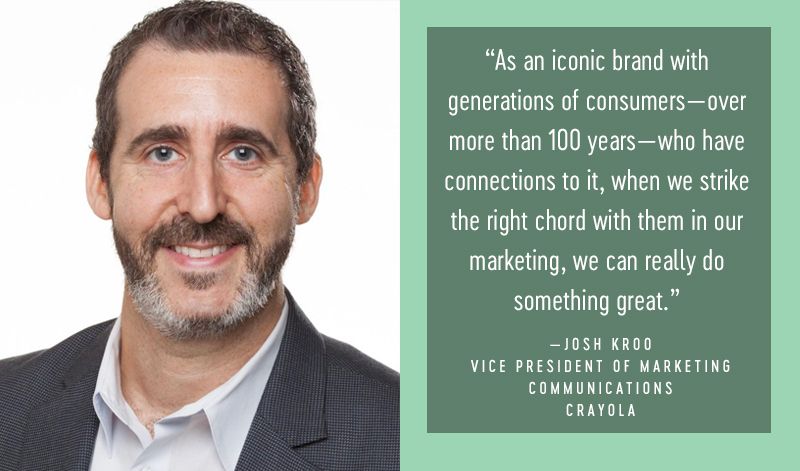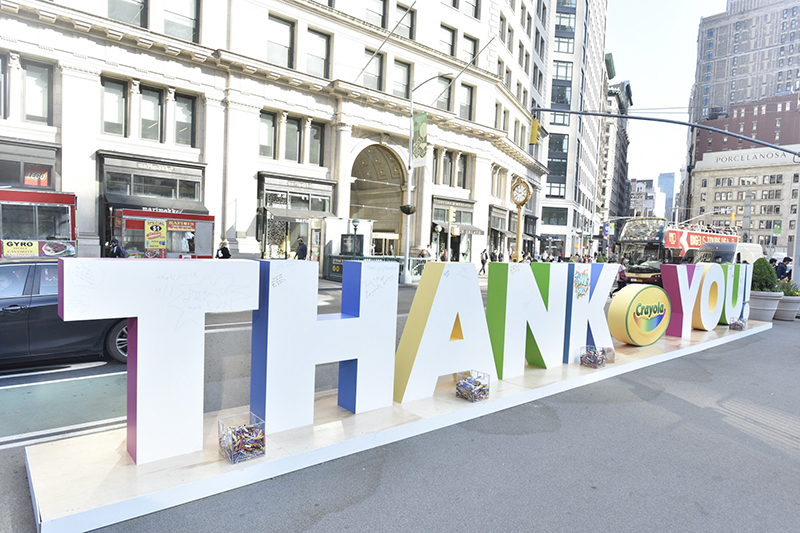

Crayola is a 115-year-old company that’s nearly synonymous with back-to-school. But even though it’s an iconic brand, it also manages to generate fresh excitement, especially with efforts like last summer’s retire-a-color campaign. Josh Kroo, Crayola’s vice president of marketing communications, recently spoke to SheReports about the challenges and opportunities of marketing a venerable brand, why inclusivity is important in its marketing and how to handle back-to-school at a company with huge market penetration.
This time last year, you were in the middle of a huge marketing blitz around the new color in the 24-count box. What are some of the challenges and opportunities around building fresh excitement for an iconic brand?
We have a mission, which is all about helping to unleash the colorful originality in every child and helping parents and educators raise creatively alive kids. When you start to think about how to build excitement for that, there are a few things that we are constantly challenged with. One is that while the brand may be huge in stature, we’re not going to go out there and outspend everybody and cut through the clutter. We have to be very strategic and think through our message and our campaigns and make everything we do work really hard for us. Another challenge is that as beloved as we are, people can sometimes just say, “Oh, yeah, Crayola, that’s great, it’s back-to-school.” And third is the always-shifting consumer behavior. It’s the adult coloring craze, it’s whether kids are using crayons or starting to use markers and pencils even earlier, it’s how kids — and even parents — are spending their free time, spending a ton more time with technology.
As an iconic brand, with generations of consumers, over more than 100 years, who have connections to it, when we strike the right chord with them in our marketing, we can really do something great. And that’s part of how we build excitement.

How did last summer’s campaign around creating the new color come together?
We wanted to tell a great brand story. We came up with the very simple idea that would strike a chord with consumers: retiring a color. We could have just done that in one day. Instead, we had a story arc with different messages, everything from teasing that retirement all the way to announcing what that new color was. Everyone has a connection to their favorite Crayola color, and this let consumers be a part of history. We really wanted to make sure we connected emotionally, by being disruptive and doing things differently. Crayola taking over Times Square with a 25-foot-tall crayon box is something we’ve never done before. But when you tell the right story [and] connect emotionally, you can really make an impact, especially with a brand like this.
…we’re not going to go out there and outspend everybody and cut through the clutter. We have to be very strategic and think through our message and our campaigns and make everything we do work really hard for us.
What’s back-to-school like for you this year?
Well, you can’t retire a color every year. But if you go back into our history, we’ve had a connection with teachers for more than 115 years. And when you think raising creatively alive kids, teachers are right there with parents. It’s a hard job, and you’re in it because of your passion. So what we wanted to do this year was make a statement to say thank you to teachers and really celebrate them.

We kicked off our campaign on National Teacher Appreciation Day in May. In Dallas, Ohio, Los Angeles, Phoenix, where we are in the Lehigh Valley, hundreds of Crayolians took that day and went into schools and shared how much we appreciate the work that they’re doing. At the same time, we went back to New York City, this time to the Flatiron district, and we launched a campaign to get North America to say thank you to teachers. We launched an advertising campaign, we launched a social campaign, and now in the summer, we’re holding a contest asking Americans — kids and parents — to say thank you to their teachers. One of the things we know in talking to teachers is that they appreciate things like gift cards and presents, but a thank you card is often one of the most impactful things they can get from a kid. And what better way to say thanks than having kids go out and say thank you to their teachers and participate in a contest where they can win everything from a classroom makeover to donations for the school and scholarships and all sorts of things like that.
We came up with the very simple idea that would strike a chord with consumers: retiring a color.
How much are you talking to the kids who use your products, and how much are you talking to the parents who buy them?
It really varies by what we’re trying to accomplish and what products we’re promoting. Year to year, it’s really a balance. You can look at a product like Silly Scents, for which we launched an awesome, pretty out there campaign about scented markers and which is clearly kid-targeted. But when you do a campaign where you’re talking about mess-free color, which is meant for little kids, that product line is going to appeal to parents. What I love about campaigns like the color campaign or even teachers are that they touch both. Kids are making thank you cards, and teachers are being appreciated by parents and kids alike.
So what we wanted to do this year was make a statement to say thank you to teachers and really celebrate them.
You’ve been a part of #SeeHer since it started. How do you think about depictions of women and girls in your marketing?
We take a pretty much gender-neutral approach, whether that’s in content we’re putting out, advertising, even packaging. It’s all about the mission, and our mission is to inspire creativity and help parents and teachers bring out that creativity in kids. So we try to be as inclusive as possible because that mission should apply to everybody, whether you’re boy or a girl, or whatever diverse background you’re from. I think if we’re not being inclusive, we’re excluding people that should be engaged in the mission. Part of the beauty of this brand is that we’ve always approached it in the same way. But it’s nice to be a part of a movement, part of something bigger that’s helping to change the way brands are communicating.
More From the Back-to-School Issue of SheReports:
- Making Cool Backpacks and Helping Children in Need
- The Importance of Believing You Can Do It and Be It: The Lower Eastside Girls Club
- Teachers Drive Back-to-School Shopping Lists
- Women Shop for Back-to-School in Retail Stores
- Confidence: The Best Back-to-School Item You Can Get
- Get Inspired
- Woman to Watch: YouTube’s Nadine Zylstra

